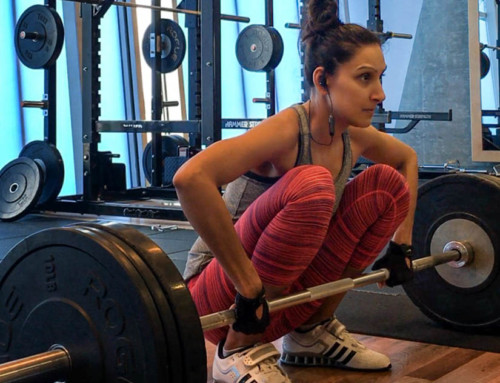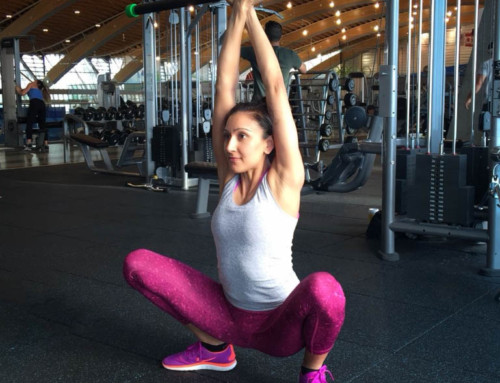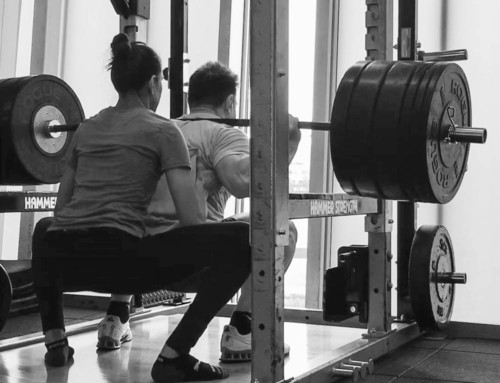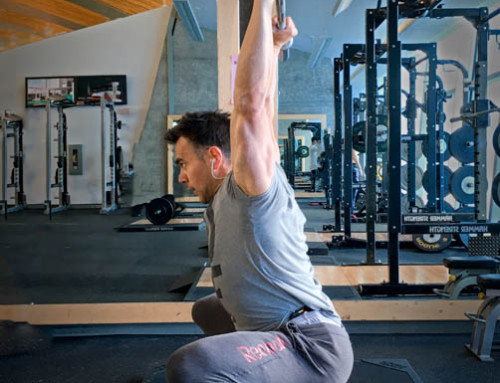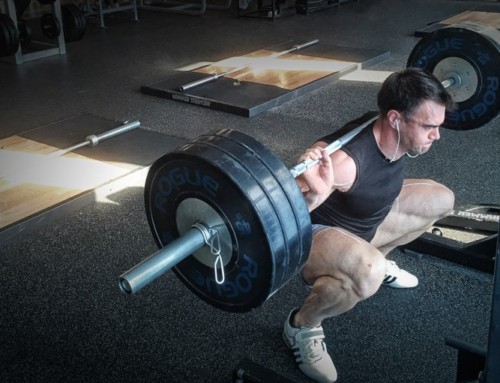Related Articles:
Strong is Sexy—6-week Strength Training Program
Power Snatch—Explosive Strength Development
We all want our training to be efficient and productive at the same time. Due to progressive popularity of Crossfit and other athletic performance training regimes, olympic weightlifting is becoming mainstream. These movements are complex, but once understood and practiced, produce a vast array of benefits for the body, mind and spirit.
Olympic weightlifting is comprised of two lifts, snatch and clean and jerk. Many training protocols insert these lifts and their derivatives to increase body physique and overall performance. Both snatch and clean and jerk are comprised of compound movements done in sequence that simultaneously challenge the body, by activating almost every muscle in the body, burning great number of calories while developing explosive strength.
In this article, we’ll discuss the derivative of clean—power clean. We’re not going to address the jerk and its variations here, as it’s another technically engaging phase. This article will simply focus on taking the barbell from the floor to the “clean” position that is seen in the beginning of the front squat.
Power Clean
Power Clean is a derivative of the Clean, by pulling the barbell off the floor into a catch position across shoulder and clavicles. The catch position with power clean is higher than traditional clean, as you perform quarter to half squat (instead of full front squat) to position the barbell onto shoulders / clavicles. This is an explosive full-body exercise, utilizing speed and focusing on the pulling movements of standard clean.
Power Clean is an easier exercise to learn and perform than its full version. Power Clean has also significant carry-over affect to other body movements and hence made its way into many strength and conditioning programs to improve sport performance and overall fitness.
Benefits of Power Clean
Power clean trains explosive strength, allowing you to produce force very quickly—power. This is accomplished by:
Greater CNS Activity
- Improved neural patterns for muscular tissue recruitment. Power Clean is a simpler version of the Clean but still places tremendous amount of physical stress on the body, engaging majority of muscles within the body in order to perform this exercise. Increase in neural drive equals recruiting more motor units (MUs) which activate associated muscle fibers (rate of recruitment) but, also continuously stimulate those fibers to produce stronger contractions (rate coding). The explosive nature of this exercise recruits all muscle tissue, and especially fast twitch ones. These contractions within muscle tissues also coordinate force production within muscle itself (intramuscular coordination) and between different muscle groups (intermuscular coordination).
Improved Fundamental Movements
- As power clean engages bending, pulling and squatting. By adding the jerk component (performed during later training phases, and it will be part of another article), you’ll also include lunging (depending on your jerk preference) as well as pushing. This is 5 out of 7 fundamental patterns and you’ll be practicing them within a single exercise.
Force Production and Absorption
- During power clean the body produces force at fast rate (rate of force development—aka RFD) where direction of the barbell is changed from horizontal to more of a vertical pull. This occurs when the bar is pulled along the upper thighs and simultaneously extending your ankle, knee and hip joints (triple extension) which is used in various body movements such as running, jumping. The triple extension is also followed by triple flexion (during the catch of the bar and decelerating it in a quarter to half squat position—eccentric control). The body is challenged through eccentric control, by absorbing and transferring forces through positioning the body during landing and deceleration of the bar itself. This great quality that is often overlooked in regular training, but specifically extracted for sports in order to improve performance and significantly decrease risk for injury.
Confidence Builder
- As in any olympic weightlifting lift or its derivative, power clean simply builds mental toughness. Power is unique in a sense where you as a lifter often commit to the lift itself, and produce force in very short time period. As technique and intensity improves with practice, so does the confidence in the lift as well as your ability.
The Technique
Power Clean is basically a continuous lift that connects deadlift and front squat. You begin by pulling the bar off the floor in a deadlift style fashion and then transitioning it upwards by using triple extension, prior to the catch position onto your front deltoids / clavicle area in a quarter or half front squat stance. Squat up with the caught bar into a standing upright position and that’s it.
Power clean is further broken down into series of pulls and pushes, each involving its own technique and set-up. Though power clean is a simpler version of its full olympic lift counterpart, it still involves level of complexity and should be demonstrated by a strength and conditioning professional qualified or educated in olympic weightlifting. However, if you don’t have a qualified coach handy, we’ll go over all necessary points for you to get started practicing and reaping great benefits that this exercise has to offer.
Working up-to Power Clean
Since functional movements within power clean include pulling, bending and squatting, we’ll focus on the exercises that improve such patterns.
Romanian Deadlifts (RDLs)
Just as with power snatch, RDLs are a great exercise to build pulling ability while improving overall hip hinge (bending component). RDLs are better option for olympic weightlifting as it loads the hips by counterbalancing the loaded bar during initial first pull, along with smoother transition (movement around and over the knees).
Front Squats
This squat version will allow you to get more comfortable with the exercise itself plus to receive (catch) the bar in this position. Front squatting greatly challenges the entire trunk while generating significant leg drive.
Barbell Shrugs with Calf Raises
This is designed to simulate triple extension. I personally start this exercise slightly bent forward. Pull the bar back until maximum height and begin shrugging it upwards while getting up on your forefeet. This exercise may feel awkward at first, and it should not be loaded with maximum intensity. The purpose is to begin and develop muscle memory for the transition from horizontal into vertical pull.
Basic Set-Up for Power Clean
- Stand next to the barbell which has been placed on the floor. The feet should be close to the bar, about an inch to inch and a half (~ 2.5 – 4 cm). A good indicator for this is that when you look down, the bar covers part of your shoe laces. Your feet should be hip width, either in a straight or slightly staggered stance. This is personal preference based on body type.
- Bend over and grab the barbell with a pronated grip at shoulder width. Some articles will discuss about using a “hook” grip where you wrap your thumb against the bar under your fingers of same hand. Let’s not focus on hooking the bar for now, as there is plenty of new technique and movements for us to lean and implement.
- Now squat down until your knees are touching at / or around the inside of the elbows. The back is flat, and hips are lower than the shoulders. Your shins may be touching the barbell. Keep your chest up while the shoulders covering the bar (if you look down, you can see that the shoulders are more or less right on top or in front of the bar).
- Keep the back tight, lats engaged, arms straight and elbows facing outwards along the bar. Tighten up the core and whole trunk.
- Now, if your gym has olympic style platforms and rubberized plates, then continue on. If your gym doesn’t carry that kind of equipment, or starting this exercise from the floor is too much of a progression for you; then simply start in a “hang” position. Hang, is the same as step 1, only starting with holding the barbell with same set up, standing up and fully erect. From there, bend forward and extend the hips back (as in reverse RDL), keeping your back straight and lowering the bar just above the knees.
Basic Technique for Power Clean
The power clean is broken down into the following movement: First pull, Transition, Second Pull, Catch and Recover. For us, we’ll stick to this nomenclature. Some texts may refer to these same power clean segments as : first pull, second pull, transition—third pull, catch and recovery. You’ll see this a lot in strength and conditioning literature, of having several names referring to same method or movement.
SLOW-MO Video of Power Clean Technique
- First Pull: Begin by pulling the bar off the floor; this is done by extending the legs while keeping the back flat and chest up. Think of maintaining shoulders and hips at same distance (as in the starting position) throughout the first pull. The shoulders continue to be over the bar, moving upwards (and not back as in a standard deadlift). As you continue to pull the bar, keep the shins close to the bar while counterbalancing it with your hips.
- Transition: As the bar reaches just below the knees and begins to move around them. Don’t rush as the leg drive often moves the knees out of the bar path. Your shoulders still in-line with the bar, arms straight and chest up. If you haven’t made body contact with the bar, you will now, around lower thigh. Keep pulling the bar towards the hip line along the middle of thighs (this position may slightly vary based on personal body style). Your knees should be slightly bent, or re-bend after the bar passes them. This is called a “scoop” or “double knee bend” creating a more powerful position for the most aggressive part of the lift. If the “scoop” is too much to think about at this stage of learning the power clean, then just leave it for now, and simply focus on pulling the bar towards that mid-thigh position. You can introduce the knee bend later, after understanding and being able to perform comfortably the whole power clean.
- Second Pull: This is the most explosive part of the power clean. Once the bar reaches maximum distance up the thighs (around mid way), explosively extend your hips, knees and ankles into a straight line. This 3-joint extension is referred to “triple extension”. As you perform triple extension, shrug the bar up with your shoulders. The arms should be straight, but there may be a little engagement from the arms. This movement often causes to jump up in the air holding the barbel. Jumping is completely fine and even taught in various gyms. As you jump up, keep the bar as close to the body as possible, and don’t allow it to shoot out or semi-circle its way upwards.
- Catch: As you pull the bar upwards begin to drive yourself under it. This happens as the bar reaches maximum vertical height, begin rotating your hands around the bar and receiving it in a racked position across the front of your shoulder / clavicle areas. The elbows should be pointing forward and fingers around and under the bar. As you’re receiving the bar, your hips and knees will simultaneously bend into a quarter-half squat. Dropping into quarter-half squat position, creates more space for the body to move under and receive the bar in a “clean” racked position.
- Recovery: From quarter squat, simply stand up, while holding the bar in racked position. The elbows still facing forward.
Reversing the Movement
If your gym has rubberized pumper plates, then simply drop the barbell from your shoulders onto the platform in front of you. If you don’t have this type of equipment, then simply revers the movement by dropping the bar from your shoulders down to your mid thighs. Flex the hips and knees slightly to absorb the barbell and cushion the overall movement. From there, simply perform a reverse RDL and lower the bar down to the floor.
Final Thoughts
Power Clean is a technically demanding exercise that requires attention, commitment and consistent practice. This exercise is designed to develop explosive strength, creating significant caloric expenditure while developing energy through anaerobic pathways. Power clean engages most of the body’s muscle tissue and CNS activity. This produces more force quickly through larger and stronger contractions within each muscle tissue as well as different muscle groups.
Power clean takes time to learn, but packs many physical and psychological benefits. Take slow and steady progressions while understanding and practicing this exercise.
Always remember: Technical mastery is first and most important. Speed comes next. And intensity is the last to join. At the end, all the great things in life take time, but are well worthwhile investments. Power Clean is a true testament of this.
We hoped you enjoyed this article, if so, please share it on your favourite social media so, we can get on google’s radar. Fell free to leave us a comment and start a discussion on the topic.
If you are looking to build strong, lean and beautiful shoulders be sure to check out our training books:

